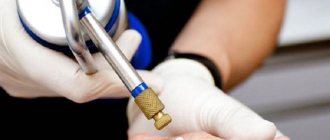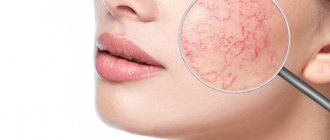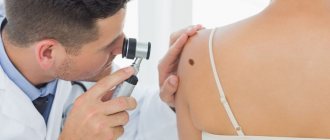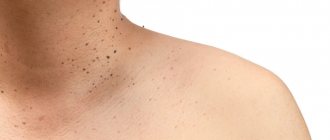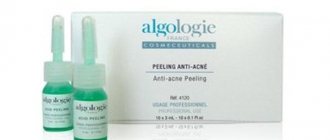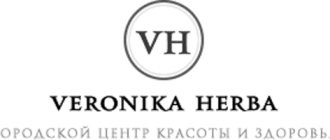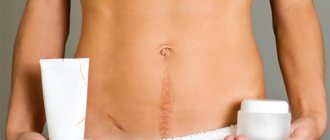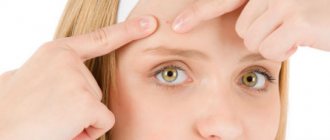Cryosurgery is the local application of low temperatures to destroy body tissue. This treatment method is used mainly for skin lesions, but also has wider applications in ophthalmology, gynecology, neurosurgery, cardiology and oncology. Pediatric cutaneous cryosurgery refers to the local application of subzero temperatures to achieve controlled destruction or removal of benign skin lesions. This method of cryosurgery is also called cryodestruction. In children, this method is used to treat molluscum contagiosum, plantar warts, and warts on the hands and fingers. Cryodestruction, unlike other surgical methods, is carried out without pain, effectively and quickly.
Cryodestruction of neoplasms
Cryodestruction is a minimally invasive technique for removing tumors using ultra-low temperatures.
It is painless, safe and has a quick recovery period. The essence of the cryodestruction method is to freeze tissues that have undergone pathological changes with liquid nitrogen. When exposed to cold, water in tissues turns into ice crystals, which damage cell membranes. Irreversible destruction (destruction) of cells occurs.
The procedure is used in cosmetology, gynecology, dermatology and aesthetic medicine to remove benign and malignant formations on the skin, mucous membranes and internal organs.
In cosmetology, cryodestruction is used to remove common and plantar (flat) warts, papillomas, moles, calluses with a core, keratosis, and condylomas.
Contraindications and complications
Contraindications to cryosurgery include cryofibrinogenemia, cryoglobulinemia, Raynaud's disease, agammaglobulinemia, and multiple myeloma.
Serious complications from cryosurgery are rare. Hypopigmentation often occurs as a result of increased sensitivity of melanocytes to cold injury. This is much more noticeable in patients with darker skin. Deeper freezing can destroy hair follicles, which can lead to alopecia patches. Although rare, prolonged freezing can result in scarring caused by damage to the basement membrane and necrosis of the epidermis. Some degree of paresthesia occurs in a quarter of patients and may persist for one to three months. Permanent sensory loss is rare and is best prevented by avoiding cryosurgery of nerve trunks (eg, preauricular areas). The risk and extent of scarring, alopecia, hypopigmentation, and paresthesia can be reduced by reducing freezing time to less than 30 seconds.
Stages of cryodestruction of skin tumors
1. Inspection. Cryodestruction is not carried out until the type of tumor is accurately determined. Usually, an inspection is enough for this. If the doctor remains in doubt, the tissue sample is sent for histological examination, and the procedure is postponed.
2. Treatment of formation with liquid nitrogen. The doctor freezes the tumor with liquid nitrogen at a temperature of -195.8 °C. To do this, either cryodestruction equipment is used with automatic supply of cooled nitrogen through a nozzle, or a miniature applicator, which the cosmetologist lowers into a thermos with liquid nitrogen.
3. Necrosis of the growth. The treated area begins to turn pale. The patient feels a tingling sensation. The doctor checks the quality of the treatment to make sure that nitrogen has affected 100% of the neoplasm tissue.
The procedure takes about 15 minutes.
Equipment for cryodestruction
In recent years, innovations in application techniques and the level of sophistication of cryosurgical devices have made cryotherapy widely used in pediatrics due to its safety, effectiveness, low cost, ease of use, absence of pain, good aesthetic results, and lack of the need for subsequent plastic or cosmetic interventions.
Modern equipment for cryodestruction allows you to get rid of problems with the use of liquid nitrogen and inaccurate application with cotton swabs. Compact hand-held cryodestructors allow the use of either high-precision atomization of a fine spray at a constant temperature of -89 ° C, or the use of contact cryodestruction using a cooled tip. A wide range of applicators are available to access different areas. Treatment of skin lesions using modern cryo-equipment is fast, safe, effective, inexpensive and does not require anesthesia.
Modern versions of cryodestructors use disposable cartridges with nitrous oxide, which allow immediate intervention, without spending time on preliminary preparation.
How long does it take for skin to heal after cryodestruction?
After cryodestruction, the treatment area turns red and swells within 2-3 hours - this means the blood supply is restored. A blister appears at the site of formation, which gradually dries out and becomes covered with a crust. The scab then peels off as new, healthy skin forms underneath. This process takes 3-4 weeks. The shade and structure of young skin will differ from the rest of the skin for some time. After 4-5 months this difference will no longer be noticeable.
Does cryodestruction hurt?
The freeze-thaw cycle immediately causes a localized, burning pain of moderate intensity, which after a few minutes gives way to a pulsating sensation and is accompanied by erythema and swelling, especially after facial procedures. After 8 hours, a serous or hemorrhagic blister usually forms, which flakes and dries within one to two weeks, forming a scab. Complete healing of benign neoplasms destroyed by cryodestruction usually occurs within two to four weeks, but can take up to six weeks for a large treatment area.
Most wounds do not require special aftercare. Bandages are best avoided. However, larger, more carefully treated lesions may require cleansing with soap and water once or twice a day. Sometimes large blisters may need to be opened. Excessive pain and swelling after the procedure can be reduced with a short course of a potent topical steroid cream.
Skin care after cryodestruction
The lesion does not require a bandage after treatment. The application site can be gently washed daily with salt water or saline. Additional care of the treated area is usually limited to a bandage to cover the area while healing, especially if the area is in an area where clothing will chafe and cause discomfort during healing.
The resulting blisters may be large and hemorrhagic (filled with blood). They should not be cut or stripped. If the size and inconvenience are significant, you can release the liquid with a sterile needle without damaging the bladder itself.
Once the blister has turned into a scab, Vaseline can be applied to soothe and moisturize the wound. Picking or cutting away the scab should be avoided to facilitate natural healing processes, allowing the scab to fall off in its own time. The rate of healing varies across different areas of the body, with scab usually remaining on the lower legs much longer than on the face or arms. In most cases, the end result will be completely normal skin without any signs of damage.
The cryodestruction procedure causes stinging, burning pain. Freezing lesions on the palms, soles, ears, lips and eyelids is more painful than anywhere else. Freezing the affected areas of the forehead and scalp can cause headaches. If necessary, you can give your child a pain reliever (ibuprofen).
Features of removing warts with liquid nitrogen
Cryodestruction is the process of destroying wart cells by exposing them to extremely low temperatures. Nitrogen is used as the main active ingredient. It liquefies at a temperature of –196 °C, and when it rises it becomes a gas again.
To remove a wart, it is treated with nitrogen using special equipment - a cryoprobe. Under the influence of such a low temperature, the water in the overgrown epithelial cells that make up the warts instantly freezes, expands and destroys them. This process can be quite painful, so in some cases local anesthesia is used.
Immediately after treatment, the wart turns white, then the operation site turns red and swelling appears. The formation of a blister filled with serous fluid and blood is a normal condition of the affected area. The process of its resorption usually takes one to two weeks. It all depends on the size of the wart, the depth and correctness of its treatment. Afterwards, a crust forms, which may peel off during the healing process. The period of complete recovery takes 2 weeks or more. Smooth, even skin should form at the site of the wart, the color of which will subsequently even out.
Stages of cryodestruction
For different purposes, different tips are used, which are selected depending on the size of the surface. In this case, the planes of contact must be parallel.
The cryodestruction process is divided into the following stages:
- Freezing tissue using liquid nitrogen. In this case, the tissue becomes dense, cold, white and insensitive. This is often accompanied by a tingling sensation, a slight burning sensation and mild pain.
- After cryodestruction, collateral edema and hyperemia occurs, lasting from 1 to 3 hours.
- The appearance of epidermal blisters, which disappear after 6-24 hours.
- Necrosis is completely rejected within 2-6 weeks. After cryodestruction, an inconspicuous spot remains, and the process of epithelization of the defect and surrounding tissue begins.
- Complete tissue regeneration occurs in about six months.
Benefits of cryodestruction
There are several ways to remove papillomas, but cryodestruction has these advantages:
● painless. Since nitrogen does not affect healthy tissue surrounding the papilloma, the patient does not feel pain. There may be discomfort if the skin is very sensitive, but strong anesthesia is not required to relieve these sensations;
● no infection occurs. No incision is made to remove infected skin. This means that infection cannot penetrate through the micro-wound;
● no bleeding. Since no incision is required to successfully perform the procedure, the vessel walls are not damaged;
● minimal likelihood of recurrence of papillomas in this location. During exposure, nitrogen damages all damaged cells. Since eventually the “sick” cells are completely destroyed, the appearance of new growths in this place is, in principle, impossible.
Another advantage of cryodestruction of warts and papillomas is the absence of side effects. After the session, most patients have no complaints. The maximum that can irritate the patient is slight redness or inflammation. But even they are not related to nitrogen, but to the carelessness of the doctor.
The procedure has no recovery period. Nitrogen stimulates tissue regeneration and strengthens local immunity, so the skin is quickly restored without additional means - ointments and solutions for treatment at home are not required.
The procedure has only one drawback: it is difficult to control the depth of nitrogen penetration. If the impact is too deep, the risk of scarring will increase. If the impact is insufficient, a second session of removing the growth may be required. However, this disadvantage can be mitigated by choosing a doctor with extensive experience.
Many patients compare cryodestruction with other methods of removing papillomas - with medical sessions in beauty salons or with folk remedies. Compared to them, cryodestruction also has advantages. For example, compared to electrocoagulation, there is less pain and a lower likelihood of scarring. In addition, exposure to electric current is not permissible if there are many papillomas and they occupy a large area on the body.
In comparison with the radio wave method, liquid nitrogen wins in two respects:
● price per session - the radio wave method requires expensive equipment;
● recovery period—after exposure to radio waves, the damaged area of skin must be sutured.
Laser therapy, like cryotherapy, quickly removes papillomas, but the body does not develop its own immunity against the virus. Therefore, in the case of laser therapy, additional medications must be used. Cryotherapy does not require additional medications.
Sometimes owners of papillomas want to remove them at home using pharmaceutical products. However, it is difficult to calculate the dose of the drug on your own, without consulting a doctor: you may not get rid of the wart, but only worsen the condition of the body. Cryodestruction is safer, as it always takes place under the supervision of a specialist.
Cryodestruction: what is the essence of the method
The properties of low temperatures to reduce pain and slow down inflammatory processes have been known to doctors since ancient times. For the first time, the technique of cryodestruction of tissues in medicine began to be used back in 1890, and to rid patients of tumors and neoplasms - in the 20s of the last century. Since the 1920s, medicine began to receive sufficient quantities of liquid nitrogen necessary for the procedure, which made it possible to carry out cryodestruction of various tumors everywhere.
From 1950 to this day, liquid nitrogen has been the main cooling agent used during the procedure.
Cryodestruction is a method of treating skin formations in which their cells are actively exposed to very low temperatures, due to which they are destroyed. Contact of a cryogenic substance - liquid nitrogen - with the surface of a basal cell carcinoma causes instant freezing of its external and internal tissues. In fact, the inside of the tumor turns to ice. Due to the fact that the extracellular fluid freezes first, high pressure is created in the tumor cells, which leads to their instant death.
Ice crystals formed during freezing carry out rotational movements around the crystallization center, destroying cell membranes. Oxygen and nutrients stop entering the body of the basal cell carcinoma, and biochemical processes stop in it. This leads to the fact that cells that did not die under the influence of low temperature die due to oxygen starvation.
The degree of success of the procedure is influenced, firstly, by its duration, and secondly, by the temperature of the liquid nitrogen used. In one and a half minutes of freezing at a temperature of -180 degrees Celsius, cryodestruction provides the most effective destruction of tumor cells.
It should be noted that after a course of radiation therapy, treatment of basal cell carcinoma through cryodestruction becomes much more difficult, since cells that have received a dose of radiation become more prone to further mutations, which significantly increases the likelihood of disease relapse.
What to do after removing a wart with liquid nitrogen
The final result after wart removal largely depends on how well the subsequent care was organized. After all, the skin receives quite serious damage during treatment with liquid nitrogen. To ensure the best healing, you need to follow these recommendations:
- After a blister appears, it must be carefully protected from damage and under no circumstances should it be punctured. If warts were removed in areas of possible rubbing with clothing, then any contact with the blisters should be avoided. If their integrity is violated, there is a high probability of infection, suppuration, and the formation of scars.
- Twice a day, blisters are treated with a solution of salicylic alcohol (2%) or potassium permanganate. This speeds up the crust formation process and provides additional protection against infections.
- It is forbidden to cover blisters with adhesive tape, as they may stick to them and cause damage. If there is a need to cover them, then you need to use loose gauze bandages or secure special gauze napkins with a band-aid, but on healthy skin.
- Blisters can be soaked with water, i.e. Showering is allowed. But you can’t rub them with a sponge or towel (just blot them gently).
- To care for blisters, scabs and skin, you should use only those products prescribed by your dermatologist. Self-medication is unacceptable.
- If severe pain occurs after the removal procedure, you can take painkillers.
If any changes are noticed on the skin that the doctor did not warn about, then you should definitely contact him for help. Usually, removing warts with nitrogen does not cause complications, but the treated areas must be carefully looked after.
Cost of the procedure
| Name | Price |
| Removal of molluscum contagiosum (as part of a consultation with a dermatologist) 1-3 units | 550 rub. |
| Removal of molluscum contagiosum (as part of a consultation with a dermatologist) 4-5 units | 700 rub. |
The information and prices presented on the website are for reference only and do not constitute a public offer. The services indicated in the Price List may be provided in other medical institutions. We ask you to clarify the address and cost of services in advance at the 24-hour call center by phone +7 (812) 331 17 04
Advantages and disadvantages of cryodestruction compared to other methods of treating basal cell carcinoma
Doctors call one of the main advantages of this tumor removal technique the low probability of relapses - usually no more than 7.5% of cases, that is, less than after radiation therapy or laser removal.
In addition, the procedure gives a good cosmetic result, especially if the patient carefully follows all wound care requirements.
Treatment is carried out on an outpatient basis, so the patient does not need to go to the hospital for this period. Only in rare cases does it become necessary to open a sick leave.
Through cryodestruction, a tumor of any size and depth can be destroyed, and for this there is no need to put the patient into a state of medicated sleep - local anesthesia is sufficient.
There is no risk of blood loss during the destruction process with liquid nitrogen. At the same time, the likelihood of tissue infection during the process of tumor removal is minimal. There are practically no complications after the operation.
Among the disadvantages of the technique, only one is significant - during freezing, the physician cannot completely and 100% accurately control its depth, due to which there is a possibility of damaging healthy tissue. In addition, a scar remains at the site of the destroyed basal cell carcinoma, albeit a minor one.
In rare cases, a course of procedures consisting of two or three sessions may be required.
Indications and contraindications of the method
Exposure to liquid nitrogen is recommended in the following cases:
- in the presence of multiple basal cell carcinomas;
- when a large advanced tumor is detected;
- for deep tumors with growth into the bones of the skull;
- patients with a tendency to form keloid scars;
- patients with an installed pacemaker.
This method is especially indicated for those affected over the age of 65, since chemotherapy in this case can provoke the appearance of other neoplasms.
In what cases is cryodestruction not prescribed to a patient? Doctors call the following contraindications to the method:
- the presence of acute inflammatory diseases of internal organs;
- pathologies of development of body tissues;
- diagnosed endometriosis and fibroids;
- infectious diseases in the acute stage;
- cold intolerance;
- some somatic diseases in the stage of decompensation.
How should a patient behave after cryodestruction?
After completing the procedure, it is important:
- when forming a bubble, try not to injure it, do not rub, do not scratch;
- in case of accidental trauma to the bladder, treat the lesion with solutions of aniline dyes (fucorcin, methylene blue) or a strong solution of manganese to prevent secondary infection;
- disinfect household items (washcloths, towels, shoes, manicure and pedicure tools);
- maintain hygiene of clothing and footwear;
- if there is redness, pain, discharge from the lesion, consult a specialist.
